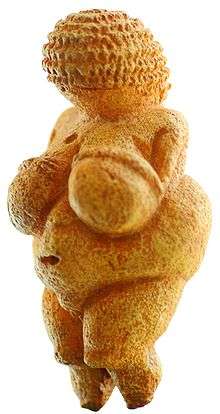Venus of Willendorf
 | |
| Material | Oolitic limestone |
|---|---|
| Created | c. 28,000 B.C.E – 25,000 B.C.E. |
| Discovered | 1908 near Willendorf, by Josef Szombathy |
| Present location | Naturhistorisches Museum, Vienna, Austria |
The Venus of Willendorf, now known in academia as the Woman of Willendorf, is an 11.1-centimetre (4.4 in) high statuette of a female figure estimated to have been made between about 28,000 and 25,000 BCE.[1] It was found in 1908 by a workman named Johann Veran[2] or Josef Veram[3] during excavations conducted by archaeologists Josef Szombathy, Hugo Obermaier and Josef Bayer at a paleolithic site near Willendorf, a village in Lower Austria near the town of Krems.[4][5] It is carved from an oolitic limestone that is not local to the area, and tinted with red ochre. The figurine is now in the Naturhistorisches Museum in Vienna, Austria.[6]
Several similar statuettes and other forms of art have been discovered, and they are collectively referred to as Venus figurines, although they pre-date the mythological figure of Venus by millennia.
Dating

After a wide variety of proposed dates, following a revised analysis of the stratigraphy of its site in 1990, the figure was estimated to have been carved 24,000–22,000 BCE,[4] but more recent estimates have pushed the date back "slightly" to between about 28,000 and 25,000 BCE.
It is believed that the figure was carved during the Paleolithic Period, also known as the "Old Stone Age". This period of Prehistory started around 30,000 BCE.[5]
Interpretation and purpose
Very little is known about its origin, method of creation, or cultural significance; however, it is one of numerous Venus figurines or representations of female figures surviving from the Paleolithic period.[7]
The purpose of the carving is the subject of much speculation. Like many figurines, it never had feet and does not stand on its own, though it might have been pegged into soft ground. Parts of the body associated with fertility and childbearing have been emphasized, leading researchers to believe Venus of Willendorf may have been used as a fertility goddess.[7] The figure has no visible face, her head being covered with circular horizontal bands of what might be rows of plaited hair or a type of headdress.[8] Alternatively, the head may have simply been textured for use as a handle. This is especially likely if the figure were intended for ecstatic-state fertility rituals or even as a masturbation aid.
The nickname, urging a comparison to the classical image of "Venus", is now controversial. According to Christopher Witcombe, "the ironic identification of these figurines as 'Venus' pleasantly satisfied certain assumptions at the time about the primitive, about women, and about taste".[9] Catherine McCoid and LeRoy McDermott hypothesised that the figurines may have been created as self-portraits by women. They speculated that the complete lack of facial features could be accounted for by the fact that sculptors did not own mirrors, though Michael S. Bisson responded that water pools and puddles served as readily available natural mirrors for Paleolithic humans.[10]
See also
- Art of the Upper Paleolithic
- Venus of Hohle Fels
- Venus of Dolní Věstonice
- List of Stone Age art
- Venus figurines
References
- ↑ Nude Woman (Venus of Willendorf), Smarthistory
- ↑ Antl-Weiser, Walpurga. "The anthropomorphic figurines from Willendorf" (PDF). Niederösterreichischen Landesmuseum,. Retrieved 24 December 2012.
- ↑ Geoffrey Bibby (1956) The Testimony of the Spade, p.139, Alfred A. Knoff, New York
- 1 2 Venus of Willendorf Christopher L. C. E. Witcombe, 2003.
- 1 2 John J Reich; Lawrence Cunningham (2013) Culture and Values: A Survey of the Humanities, 8th Ed., Andover, Belmont, CA ISBN 978-1-133-95122-3
- ↑ Witcombe, Christopher (2003) Venus of Willendorf, retrieved 2008
- 1 2 Lawrence Cunningham; John J Reich (2006). Culture and values : a survey of the humanities. Belmont, CA: Wadsworth. ISBN 978-1-133-94533-8.
- ↑ "Woman from Willendorf". Her headdress replicates shell formations. Christopher L. C. E. Witcombe. 2003. "The rows are not one continuous spiral but are, in fact, composed in seven concentric horizontal bands that encircle the head and two more horizontal bands underneath the first seven on the back of the head."
- ↑ "Name". Christopher L. C. E. Witcombe, 2003.
- ↑ "Self-Representation in Upper Paleolithic Female Figurines". Current Anthropology, Vol. 37, No. 2, April., 1996. pp. 227–275.
External links
| Wikimedia Commons has media related to Venus of Willendorf. |
|
|
- Christopher L. C. E. Witcombe, "Women in Prehistory:Venus of Willendorf".
- Venus figures from the Stone Age - The Venus of Willendorf
- The Invisible Sex: Uncovering the True Roles of Women in Prehistory by J.M. Adovasio, Olga Soffer and Jake Page, ISBN 978-0-06-117091-1, gives a new 'view' of headdress as possible model for weaving a basket; Lauran Miller review at Salon.com:
Coordinates: 48°19′N 15°23′E / 48.317°N 15.383°E